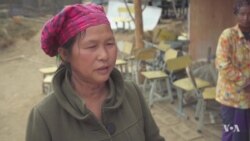A cold wind sweeps across the rocky hilltops of Myanmar’s Sha It Yang camp, where the Kachin Independence Organization says 5,000 of its internally displaced civilians have struggled to call home since relocating there from the Zai Awang and Maga Yang camps in December of 2016.
Inside a long wooden hut, a chorus of youthful voices singing a traditional song gives the appearance of stability; but, in reality, nothing is further from the truth.
Most of the children and teenagers have faced repeated displacement after being attacked by the Myanmar military, often under heavy artillery fire.
Thirteen-year-old Hpare Ja Nupan's family of nine has been uprooted four times since fighting between the military and guerrillas of the Kachin Independence Army, an ethnic armed group, resumed in 2011 after a 17-year cease-fire pact broke down.
"When I lived in the Zai Awg IDP camp, I thought there would be no more running away from the fighting, but it happened again just like before," she quietly explained, as tears welled up in her eyes.
"The Burmese army shot inside the camp, and the artillery shells dropped in our IDP camp. So, we had to flee and hide in a big tree near the river."
Nearly 100,000 internally displaced persons remain in 165 camps in Kachin and Northern Shan state, according to the UNHCR, and many of themhave faced repeated displacement since the resumption of the conflict.
As Myanmar is largely an agrarian region, farm families make up a large part of the camp population. For most, the loss of land also means a loss of earnings.
Many of the landowners fled their property without taking their land documents. Now, civil society groups report foreign companies are buying up large tracts of property deserted by local Kachin families, dimming any hopes the IDPs have of returning home.
Along with the fertile land, valuable mineral resources in the region are a key cause of the ongoing attacks and displacement.
Global Witness, a Washington-based organization that exposes corruption and environmental abuse, estimated the jade mines in the Hpakant region of Kachin state generated a revenue of $31 billion in 2014 alone.
There are also vast tracts of land containing amber and gold reserves, primarily in Kachin state's Tanai township, where most of the Sha It Yang IDPs originate.
At least $1 billion of legitimate amber trading takes place in the country yearly.
Farmer Nhkum Awng Law, who’s been displaced four times, now makes a meager income carving out bamboo cups for sale in the local market, despite his farmland property located near rich reserves of amber in Tanai Township.
"I feel like the Burmese army targets Kachin people because we have many natural resources like jade and gold mines, the 54-year-old said, as he sanded the edge of a wooden handle.
"They are jealous of us and want to steal everything. That's why they attack the Kachin."
Last June, Myanmar army helicopters scattered leaflets over the township, warning people in the mining areas to leave by June 15 or be seen as supporting the Kachin army, according to the Democratic Voice of Burma, a leading Myanmar news outlet.
The leaflets, seen by VOA, stated the Myanmar army would not be responsible for anyone injured in the ensuing clearance operations of the targeted territory, to prevent further damage to the environment by amber miners.
“The military is trying to improve itself with the democratization on the way,” says Nyo Mint, director of National Reconciliation and Peace Center, an organization formed by the NLD - led government in 2016. “This is why they warned in advance in a conflict area to prevent any civilian casualties so that the civilians can move out of the area.”
More than a thousand miners and their families fled the area and were temporarily sheltered in church facilities around Tanai town.
Food, water and medicine are in short supply at many of the camps as the Myanmar government increasingly restricts the movement of international aid into the ethnic army-controlled territory of Kachin state.
Many of the IDPs receive donations from local church-based groups, but it's not enough.
"The food supply has been blocked from inside Myanmar, so we often receive it from the China side of the border," said Sha It Yang camp co-leader Hpau Besan Shaung.
Only one medical clinic exists in the remote camp. To save money, many of the basic health problems are often treated with home remedies and natural herbs.
"I'm learning how to use herbs for medicine and treatment and also use them to heal diabetes for people in the IDP camp," said Lahpai Nang Bawk, attending an open-air meeting led by a few local doctors.
"We're taught how to use herbs to treat the decayed teeth and paralysis, so we need to learn from an expert medical doctor," added the 53 year-old mother whose family has been displaced four times.
Despite Myanmar's economic growth, which the World Bank estimates slowed to 5.9 percent last year, the ethnic areas, including Kachin state, have yet to benefit because of the ongoing conflict.
As peace talks stall with only two fringe groups joining the latest additions to the Nationwide Cease-fire Agreement's eight original signatories, the KIA has re-formed a new alliance - the Federal Political Negotiating and Consultative Committee (FPNCC) - with ethnic armed groups close to the China border and led by the United Wa State Army.
"The Chinese government finds the way to help our group negotiate with the Burmese government," said Gen. Zau Tawng, head of security for the KIA.
"Every ethnic armed group that lives on the China border has joined together to become united, and the Chinese government supports the FPNCC."
The new alliance comprises 80 percent of the ethnic armies. With no signs of peace, most IDPs are preparing for an extended stay in the newest border camp.
KACHIN STATE, MYANMAR —







